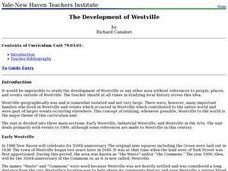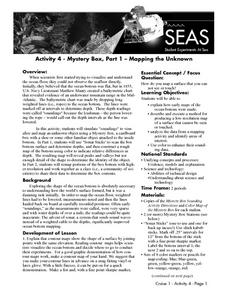Curated OER
How Does Radon Get Into Your Home?
Students complete an experiment in which they measure the radon level in their home. They examine the different types of units of measurement and practice using them throughout the activity. They calculate surface area on objects as well.
Curated OER
Social Studies: Westville Through the Years
Pupils research the history of Westville, Connecticut by investigating three main areas of study. They begin with the town's early history, examine its industrial era, and conclude with its influence in the arts. The lesson includes...
Curated OER
Art From Map-Abstract composition using map and primary colors
The students use a map to create a Mondrian-like artwork. They put to use his severe simplicity in line as well as in color (of course, no green, which was a color he reportedly hated). Shapes created were more organic rather than...
Curated OER
True Settlers of the Pacific Northwest: Who was there with Dr. John Mcloughlin?
Students discover who was present when the city of Vancouver was founded. Using the internet, they research the various cultures of the area and which were present at the Hudson Bay Company. They discuss each person's role in how the...
Curated OER
Problem-Based Research Lesson: Wilderness Issues
Students read and discuss articles relating to the theme "How should we deal with the growth of towns and human populations into wilderness areas?" Based on the class brainstorm, each student generates a research topic. They are grouped...
Curated OER
Problem-Based Research Lesson: Wal-Mart Debate
To prepare for class, learners will read several articles (links included). Students discuss the articles, and ways to deal with the proliferation of big-box stores in rural areas. The class takes two minutes to generate a research...
Curated OER
New Boxes from Old
Ninth graders take a rectangular box (e.g., a cereal box) and cut it up to make a new, cubical box with the same volume as the original. In so doing, they will discover that because the cubical box has less surface area than the...
Curated OER
How Does Climate Influence Civilization
Young scholars demonstrate their knowledge of the Earth's systems. In this climate lesson students identify the climate of a chosen area and the effects it has on the lifestyles of those living there.
Curated OER
To Classify Beans And Peas
First graders record information on a bar graph and interpret the information given. They identify five different kinds of beans and three different kinds of peas. They work in groups of four and sort the beans by size or shape.
Curated OER
Cultural Cups
Students create their own drinking vessel from papier-m??ch??. They experiment with different shapes for drinking vessels and different patterns for them.
Curated OER
String of Fish
Fourth graders research a Florida fish to determine its length. They display this information on two index cards, which are cut to the shape of the head and the tail and attached to a string that they measure and cut to the correct...
Curated OER
Carbondale: The Biography of a Coal Town
Students use a brief history of the growth and decline of the anthracite region in the state to create a photograph and map "peak shaped" time line. They practice map and photo analysis strategies to "read" photographs and maps.
Curated OER
Let's Have a Lesson Within a Lesson
Students role-play the role of a student who does not comprehend the language the lesson is being instructed in. Using the internet, they research the characteristics, distribution and migration of human populations over time. In groups,...
Curated OER
Sixth Graders Express Themselves
Sixth graders create examples of expressionistic paintings using pastels, black paper, and chalk in this 6th grade Art lesson. Emphasis is on creating an emotion for the painting using simple lines and large shapes and cooperative...
Curated OER
Mapping the Unknown
Pupils explain how early maps of the ocean bottom were made. They describe and execute a method for producing a low-resolution map of a surface that cannot be seen or touched. Students analyze the data from a mapping activity and...
Curated OER
Visual Arts: Using Imagery
Students extend the colors, shapes, textures and lines of an unknown composition to create perspective in their drawings. Using oil pastels, they work in pairs to create a long continuous artwork of imagery inspired by sailing vessels...
Curated OER
The Driving Force
Students work in groups and note similarities and differences between their boats: size, shape, color, and unique features. They discuss 3 typical means of propulsion: propellers, sails, and paddles then share their charts with the class.
Curated OER
Bones or No Bones?
Students move to music and study bones and their purpose. When the music plays slow, gentle sounds the students have NO bones and their bodies are like Jello or an egg that has been cracked open on the floor . When the music changes...
Curated OER
Sun and Shade
Students explore the ways that plants adapt to their environments. They examine plants that thrive in the shade, versus plants that thrive in direct sunlight. Special attention is devoted to the shape of leaves on respective sun and...
Curated OER
Cells, The Structural and Functional Units of Life
Students observe the general structure and organelles of plant and animal cells. Students prepare microscope slides of elodea, onion, check, and cork and identify the cells by size and shape as unicellular, multicellular, plant or animal.
Curated OER
Powerful Potato
Third graders recognize the importance of geography in shaping a settlement where people can live. In this community location lesson, 3rd graders participate in a potato growing activity to understand how it helped a community...
Curated OER
Mystery Boxes
Students make observations about Mystery Boxes that their teacher has made up and describes the motion of the object inside the box and hypothesizes it's shape based on their observations.
Curated OER
Prime and Composite Numbers
Sixth graders inspect prime and composite numbers. Using graph paper, they draw as many different shaped rectangles as possible. They use the dimensions of the rectangles to discuss prime and composite numbers. Students create a chart...
Pennsylvania Department of Education
Seeing Doubles
Students work with dominoes to recognize the number of spots on each side as they relate to addition facts. In this seeing doubles lesson, students make triangle shaped flash cards for the double facts. Students represent the correct...
Other popular searches
- Geometry Shapes Area
- Geometry Shapes Area Formula
- Finding Area of Shapes
- Estimate Area of Shapes
- Shaded Area of Shapes
- Math Area of Shapes
- Surface Area of Shapes
- Area of Shapes Worksheets
- Compound Shapes Area
- Surface Area of 3 D Shapes
- Math Area Irregular Shapes
- Geometry Shapes Area Similar























